Fashion customers are increasingly demanding products and services that do less harm to or benefit the environment. It’s important that they can make informed choices based on claims they can trust.
The Competition and Markets Authority (CMA) has published this guide to help fashion businesses stay on the right side of consumer law. Drawing on lessons from our recent investigation into ASOS, Boohoo and George at Asda, we explain how you can follow the Green Claims Code when making environmental (or ‘green’) claims.
This guide focuses on retailers but is also relevant to those who manufacture or distribute products.
Wherever you are in the supply chain, you’re responsible for making sure your claims are accurate and backed up. If you don’t, you risk breaking the law, having to pay back your customers, and significant harm to your business’s reputation.
This guide is not exhaustive. Look at all aspects of your business practices and think about any other changes you should make too.
Make your claims clear and accurate
All your green claims must be clear and accurate. This is the case whether they’re made on a product (including on labels), in advertising, in store or online.
Don’t hide important information. Instead:
- use plain language
- make it clearly visible
- present in a way that customers can easily understand
- put it close to the green claim you make
Customers should not have to do something, like follow a hyperlink or scan a QR code, to find this information. It should be on the same side of a tag, or next to a claim on a website. It shouldn’t contradict the claim either.
You can provide some types of supporting information separately to the claim, like on an adjacent tag. Read our full guide for more.
Avoid using unclear terms like ‘green’, ‘sustainable’ or ‘eco-friendly’. They’re more likely to mislead customers into thinking that the product as a whole has a positive impact on the environment (or not a negative one, at least), which might not be true.
Remember: if you can’t prove that what you claim is true, you risk breaking the law.
We’ve created some example claims that are likely to mislead customers. Can you spot what’s wrong with each one?
Example 1 – a ‘planet-loving jacket’

🚫 The ‘fashion fail’
This social media post refers to a jacket as ‘planet-loving’ and includes earth and leaf emojis, without any explanation. This could be misleading because the basis for the claims and presentation is limited. For example, if the reason for the claim is that the jacket can be recycled under certain circumstances, then the overall presentation is likely to give customers a misleading impression of the jacket’s green credentials.
🧷 The ‘fashion fix’
Do not use visual signs like logos, icons or images in a way that could mislead customers about your product’s impact on the environment. Think about the overall impression you create: is it misleading? Do you need more information to explain the images you use?
👕 The ‘fresh fit’
The post would be less likely to mislead if it used something like a recycling symbol next to a statement that explains how the jacket can be recycled. For example, ‘this jacket can be recycled in store’ or ‘via our take-back scheme’.
Example 2 – a collection made of ‘better materials’
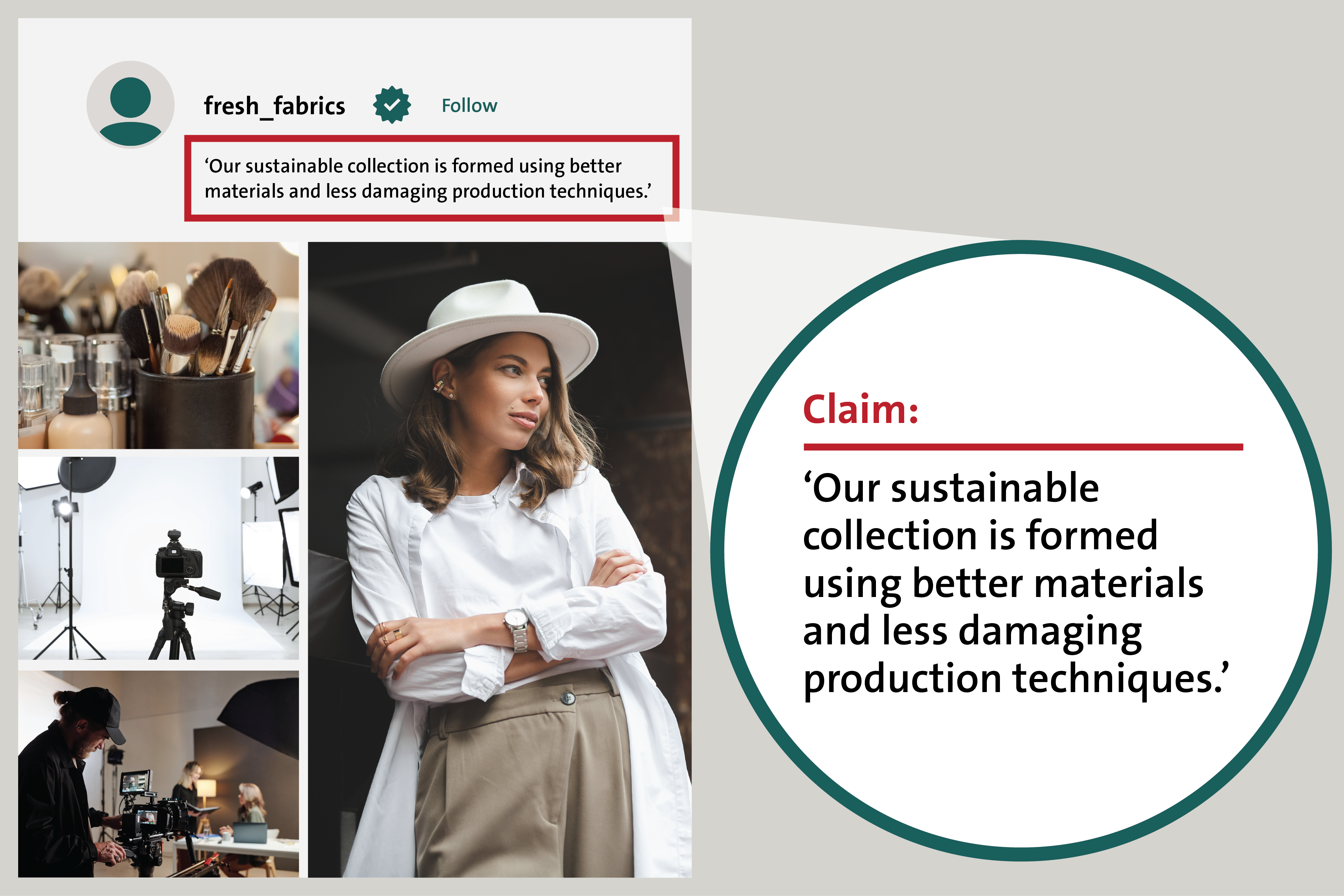
🚫 Fail
This social media post claims that the company’s ‘sustainable collection is formed using better materials and less damaging production techniques’.
Using comparative terms like ‘better materials’ or ‘less damaging’ could be misleading because the basis for the comparison is not clear. The customer does not know what the items are being compared to, and there’s no more information to explain the claim.
🧷Fix
If your claim makes a comparison – like saying one product uses less water than another – then provide at least a summary of the basis for that comparison. Make this summary clear and prominent. Show it close to the claim, like on the same side of the product tag.
Ask yourself if:
- the claim is comparing like for like
- it’s clear to the customer what is being compared, and how the comparison is being made
- the basis for the comparison is fair
Customers should be able to make informed choices about competing products and businesses, or between different versions of a similar product.
👕 Fresh fit
A better statement would be something like:
‘Our new denim range uses 50% less water than our previous range in the washing, ageing and finishing process.’
This provides a clearer basis for the comparison.
Example 3 – an ‘eco-friendly kid’s coat’
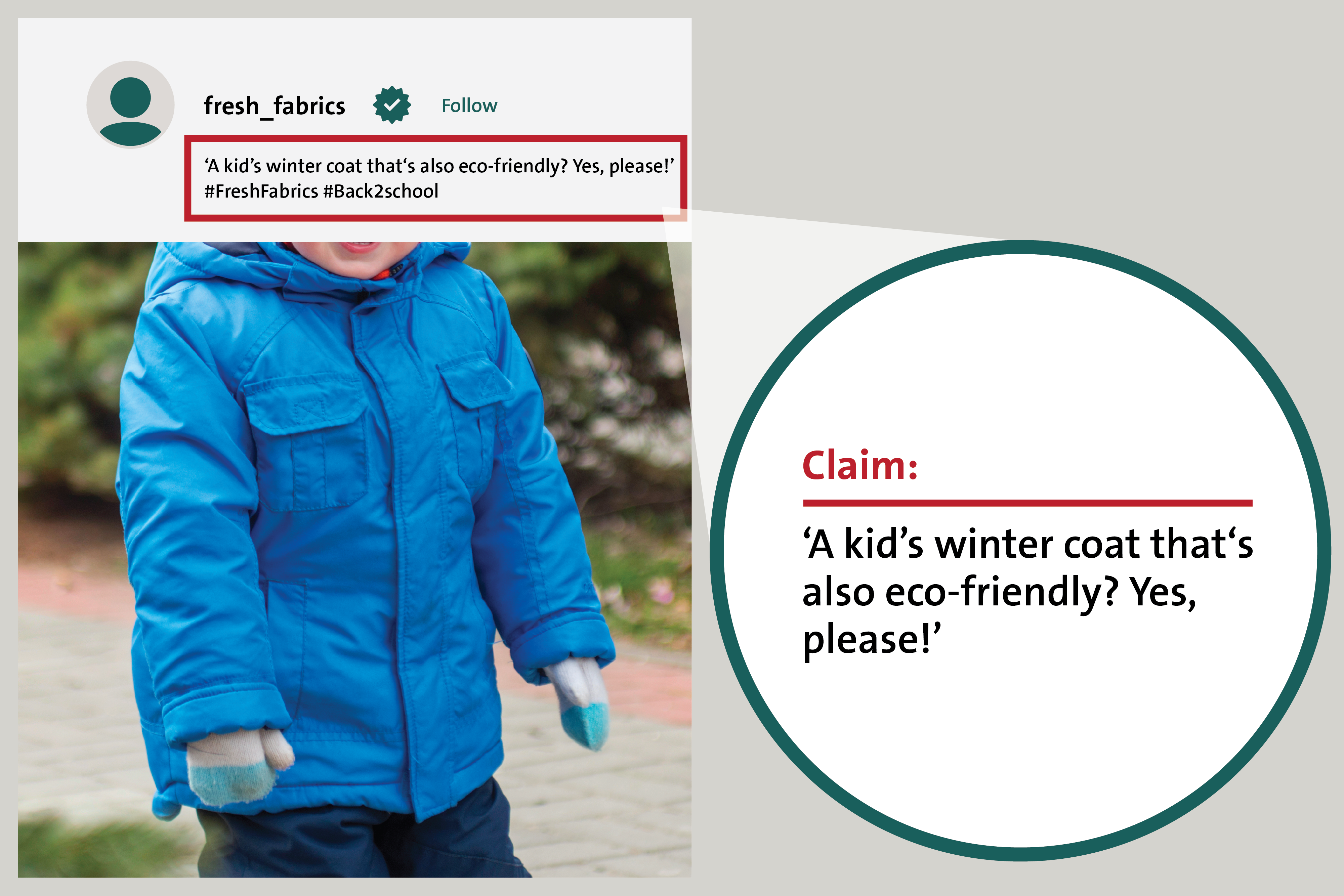
🚫 Fail
This post claims that a kid’s winter coat is also ‘eco-friendly’. But it doesn’t explain that the reason for this is the sleeves have a hidden hem that can be unpicked to extend them, allowing a growing child to wear the coat for longer. In other words, the customer must do something to make the product last longer.
Also, words like ‘eco-friendly’ are difficult to understand and can exaggerate the product’s green credentials.
🧷 Fix
If you make a claim which is only true if the customer does something, then you need to explain that action (unless it’s already clear from the context). Make this clear and prominent. Show it close to the claim, like on the same side of the product tag. This will help the customer make an informed choice.
👕 Fresh fit
A post like this would be better for staying on the right side of the law:
‘A kid’s winter coat that’s made to be worn for longer, with sleeves I can extend? Yes, please’
Example 4 – ‘recycled’ clothes on a website filter

🚫 Fail
On this website, the menu includes an option for ‘recycled dresses’. This contains a selection of dresses that are either only partially made from recycled materials, or do not contain recycled material.
Referring to the group of products as ‘recycled’ could mislead customers into thinking that all the dresses in the group are entirely made of recycled materials.
🧷 Fix
If your website or app uses tools like filters or drop-down menus to help customers find products based on their green credentials, then you should present these tools in a way that doesn’t mislead customers.
Avoid giving the impression that a group of products, or specific products in the group, are better for the environment than they really are. Don’t use words like ‘sustainable’ in filters unless your products are truly sustainable. Instead, refer to specific characteristics like ‘50% recycled’.
👕 Fresh fit
A filter that clearly states the minimum criteria for inclusion, like ‘at least 50% recycled content’, would be more likely to follow the law.
Example 5 – an ‘environmentally conscious’ range

Extract from website text:
🚫 Fail
This website invites customers to ‘explore our exclusive, curated range of environmentally conscious fashion products. Step into Sustainable Edit and discover a selection of beloved brands and products crafted from responsible materials all in one place.’
It could be misleading to describe the product range as ‘environmentally conscious’, ‘sustainable’ and made from ‘responsible materials’, without any further explanation. Customers could falsely believe that items in the range are better for the environment than they really are.
The name of the range also risks misleading customers.
🧷 Fix
You might sell a range of products, grouped according to specific criteria relating to their impact on the environment. This might be a collection, capsule collection or limited release (like a time-limited ‘drop’).
Make the criteria for these ranges clear. If you don’t, customers might mistakenly believe that the products in the range have a better impact on the environment than they actually do.
Explain the criteria in full. Make this explanation clear and prominent. If you are selling online, this should be where it is easy for customers to find it. If you are selling in store, this should be somewhere customers can see it before they buy.
Give ranges a clear name. Words that are unclear or too broad could give customers a misleading impression.
Do not include a product in a range if it does not meet the criteria for inclusion. If you are advertising a range and mention specific products, the products you mention should meet the criteria for inclusion in the range.
👕 Fresh fit
The website would be less likely to mislead customers if it used clearer and more precise language to describe the range and provided the criteria:
‘Explore our exclusive and curated range and discover a selection of beloved brands and products made using at least 75% recycled or organic content all in one place. For the full range criteria, click this link…’
Example 6 – an ‘organic cardigan’
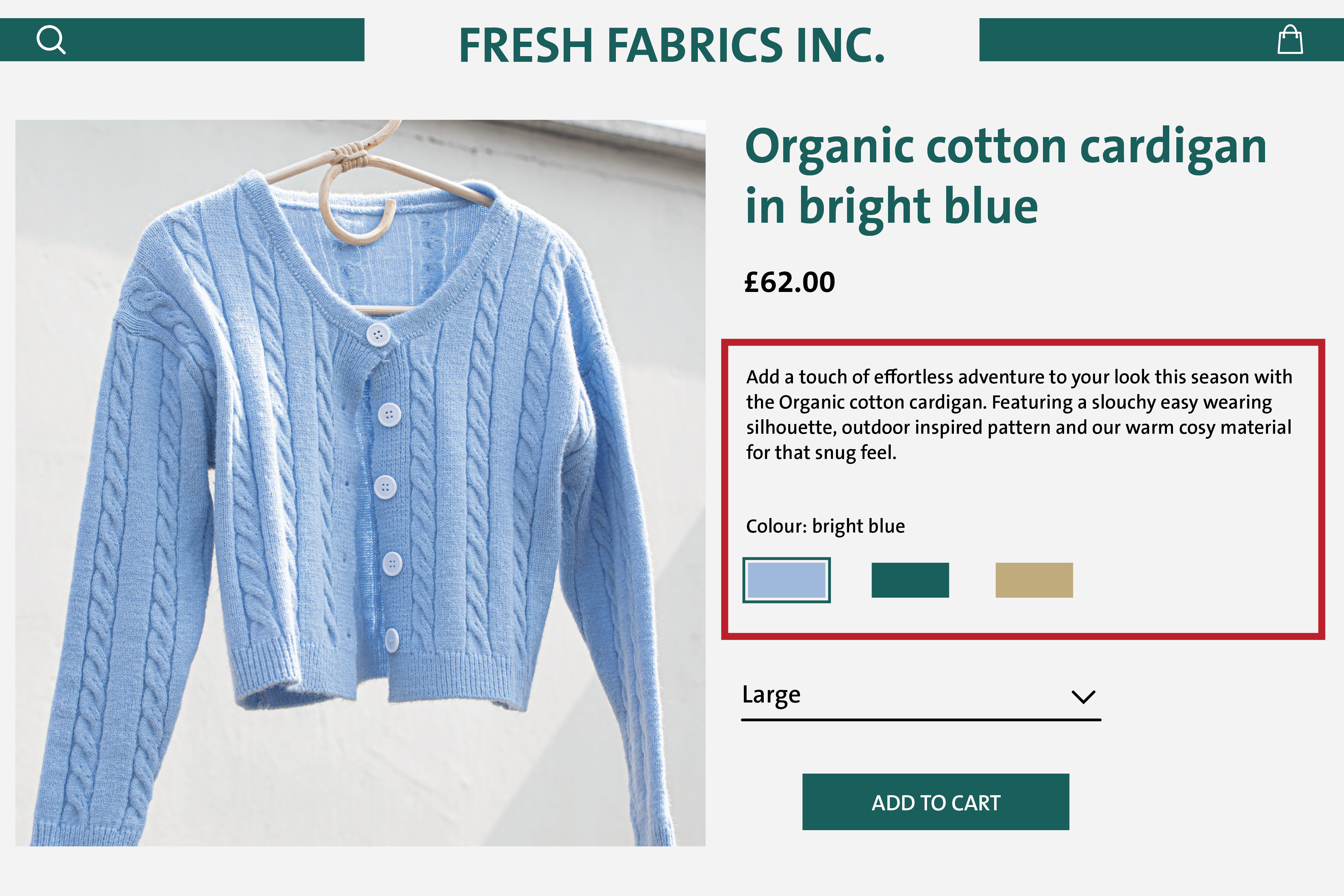
🚫 Fail
This cardigan is described as ‘organic’. The product information, which is not obviously visible on the product page, states that the cardigan is made of ‘50% organic cotton, 50% cotton’.
Using the word ‘organic’ in the title, when the cardigan only contains 50% organic material, is likely to mislead customers. The title does not specify the proportion of organic material, which could lead the customer to falsely believe that the entire cardigan is made of organic cotton.
🧷 Fix
If you make a green claim about a product because it contains certain types of fabric, then be precise. Refer to the objective properties of each fabric, like ‘recycled polyester’ or ‘organic cotton’. Don’t use more subjective or ambiguous words like ‘environmentally-conscious nylon’ or ‘responsible cotton’.
Don’t imply that a product is entirely made of a single fabric if this is not true. For example, a product is not ‘recycled’ or ‘organic’ if it contains fabrics that are not recycled or organic (unless the proportion of non-recycled/non-organic fabrics is negligible). Specify the percentage of recycled or organic fibres in the product.
👕 Fresh fit
Using a title like ‘Bright blue cotton cardigan with 50% organic cotton’ would more accurately reflect the cardigan’s fabric characteristics.
Example 7 – the GOOD FABRIC Scheme
We’ve made up a fictional GOOD FABRIC Scheme, under which a fabric is sourced through a mass balance credit system (where the supply chain can mix sustainable material with conventional materials).
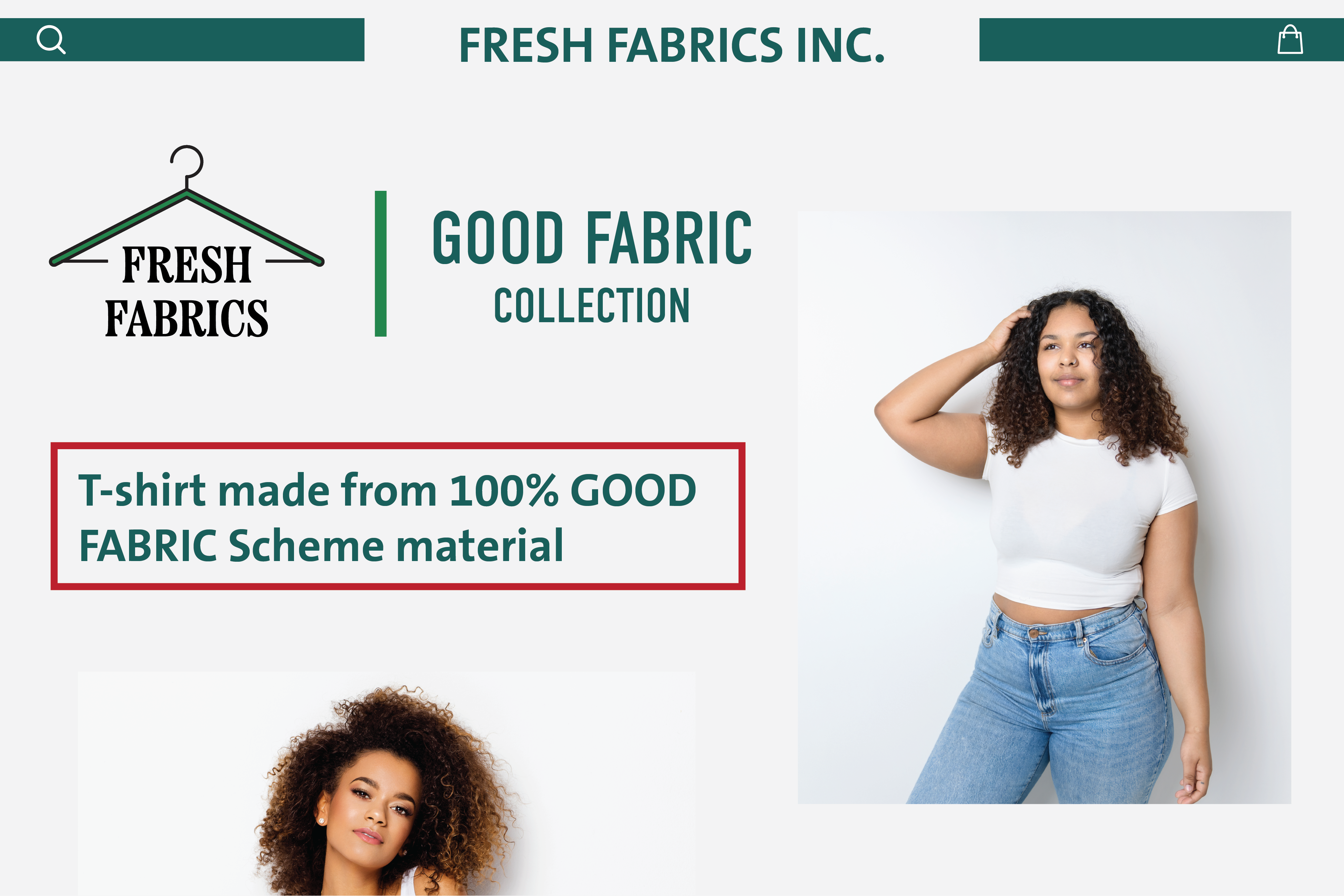
🚫 Fail
This tag claims that a t-shirt is ‘made from 100% GOOD FABRIC Scheme material’. This is more likely to mislead customers if the material being referenced can’t be traced to the final product under the accreditation scheme, which could be the case in mass balance schemes.
🧷 Fix
There are affiliation and accreditation schemes that provide certain assurances, such as about raw materials or fabrics.
Some schemes prove that a product has certain characteristics. Only refer to these schemes in relation to a specific product if the product has those characteristics.
If you make a claim that is based on or references an affiliation or accreditation scheme, then you should provide:
- a summary of the environmental benefits that can be properly associated with this
- details about any connections you have to that the scheme
- a way for the customer to find out more about the scheme (like a hyperlink or QR code)
- a clear and prominent link to the scheme’s website
👕 Fresh fit
A statement like this would be less likely to mislead customers:
‘By buying this T-shirt you are supporting the GOOD FABRIC Scheme’s pesticide-free farming programme. This T-shirt may contain material that is conventionally farmed, find out more via this link (with a link or QR code leading to further details about the scheme).’
Example 8 – a claim about water usage and waste
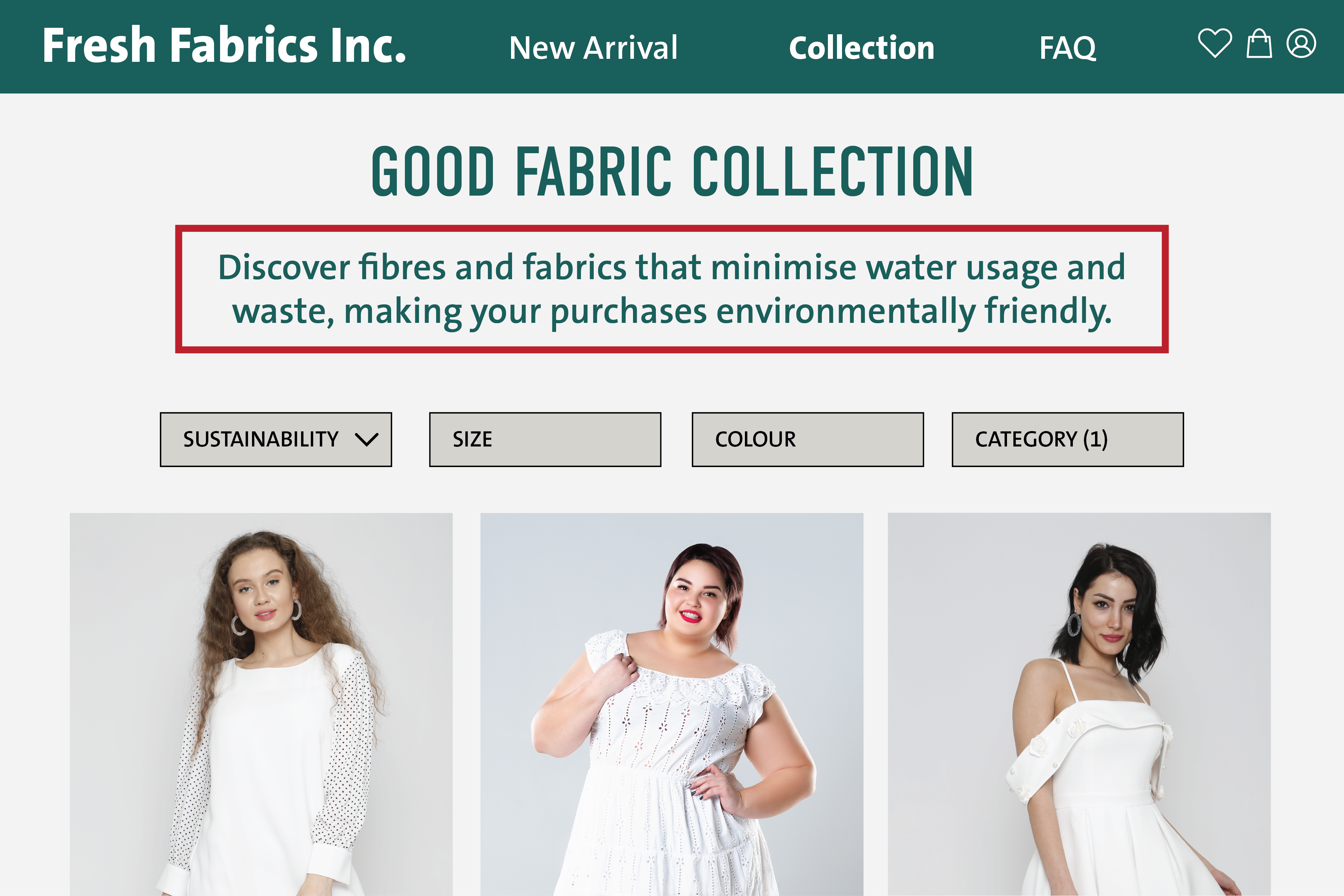
🚫 Fail
In describing a product collection, this website invites customers to ‘discover fibres and fabrics that minimise water usage and waste, making your purchases environmentally friendly.’ What isn’t explained is that the reference to minimising water usage and waste relates only to the raw material production stage.
Without this being clear, the statement could mislead customers into thinking that the claim relates to the whole manufacturing process of these items.
🧷Fix
If you make a claim based on a specific part of a product’s life cycle, then summarise the relevant part of the life cycle. Make this summary clear and prominent, and allow the customer to find more information.
👕 Fresh fit
A statement like this would be less likely to mislead customers: ‘This garment is made using a cutting process that minimises waste.’
Example 9 – a sustainability commitment

🚫 Fail
Fresh Fabrics Inc. claims it is ‘committed to creating a better world and promoting sustainability through all our actions’. This claim is broad, aspirational and unsubstantiated – and likely to be misunderstood by customers. Similarly, phrases like ‘we are on a journey’ or ‘it’s the beginning’ could create the impression that more improvements are still to come, without being specific about what those improvements are. No detail is given about how the business will make changes.
🧷 Fix
Only make green claims that are based on or reference corporate targets if you have a clear and verifiable strategy in place to meet these targets.
Make sure that customers understand the terms you use to explain claims. Don’t make claims that create a misleading impression about the impact of your fashion retail business as a whole on the environment.
Provide at least a summary of the nature of the target. Make this summary clear and prominent.
Include further information about:
- what the target is trying to achieve
- the date on which you expect to meet the target
- the main ways by which you intend to meet the target
You could make this further information available through something like a hyperlink or QR code.
👕 Fresh fit
A statement like this would better explain the target:
‘Our goal is for 100% of the cotton we use to be organic by 2030, and we are working with organic farmers to secure this. Currently, half of the cotton we use is organic. Find out how we aim to achieve our target by clicking this link.’
Be ready to back up your claims
Have internal processes in place to make sure all your green claims are accurate and do not mislead customers. These processes include appropriate policies, regular training for staff, and systems to check your product listings are correct and that certain products meet advertised range criteria.
You should:
- be able to back up any claims you make before you make them
- have robust, credible, relevant and up-to-date evidence that supports the claims; and
- have internal processes in place to minimise and correct mistakes when listing products for sale
Your suppliers should also be able to back up your claims with evidence. In the fashion sector, this evidence often includes final scope certificates or final transaction certificates.
Make sure your suppliers can provide relevant certificates on request. It’s good practice to carry out regular spot checks of certificates, check your suppliers have read and understood your policies about green claims, and verify that product information is accurate before you put it on sale.
You are responsible for any claims made about third-party products you sell. Satisfy yourself that these claims are not misleading. Each business in the supply chain is responsible for making sure its claims are accurate and appropriately substantiated.
Recap: things to check before you make a claim
- The claim is written clearly and accurately
- Important, qualifying information is easy to find and understand – it’s close to the claim being made
- The meaning of any term used will be clear to the customer
- You have evidence to support any broad or general term being used
- The meaning of logos, icons and images will be clear to the customer
- The claim creates an accurate overall impression
- If the claim makes a comparison, then the basis for the comparison is clear and fair
- If the customer needs to do something, then this is explained clearly
- It’s clear which conditions or criteria apply for a product to be included in a filter or navigational tool
- Any product included in a filter actually meets the relevant criteria
- The name of a product range is clear and accurate
- The range criteria are available, and a summary is provided
- All products in a range meet the criteria for that range
- Fabrics are referred to by their intrinsic characteristics, not vague terms
- The product is made entirely from a particular fabric, where this is the impression given
- The fabric composition percentages are made clear
- If the claim refers to an affiliation or accreditation scheme, then the benefits of the scheme have been summarised, any connection between you and the scheme is clear, and further details are provided
- If the claim relates to a specific part of the product’s life cycle, then this is made clear
- If the claim refers to an environmental target, then there’s a clear and verifiable strategy in place to deliver the target (and this has been explained to the customer)
- You or your supplier is ready to back up the claim with evidence
